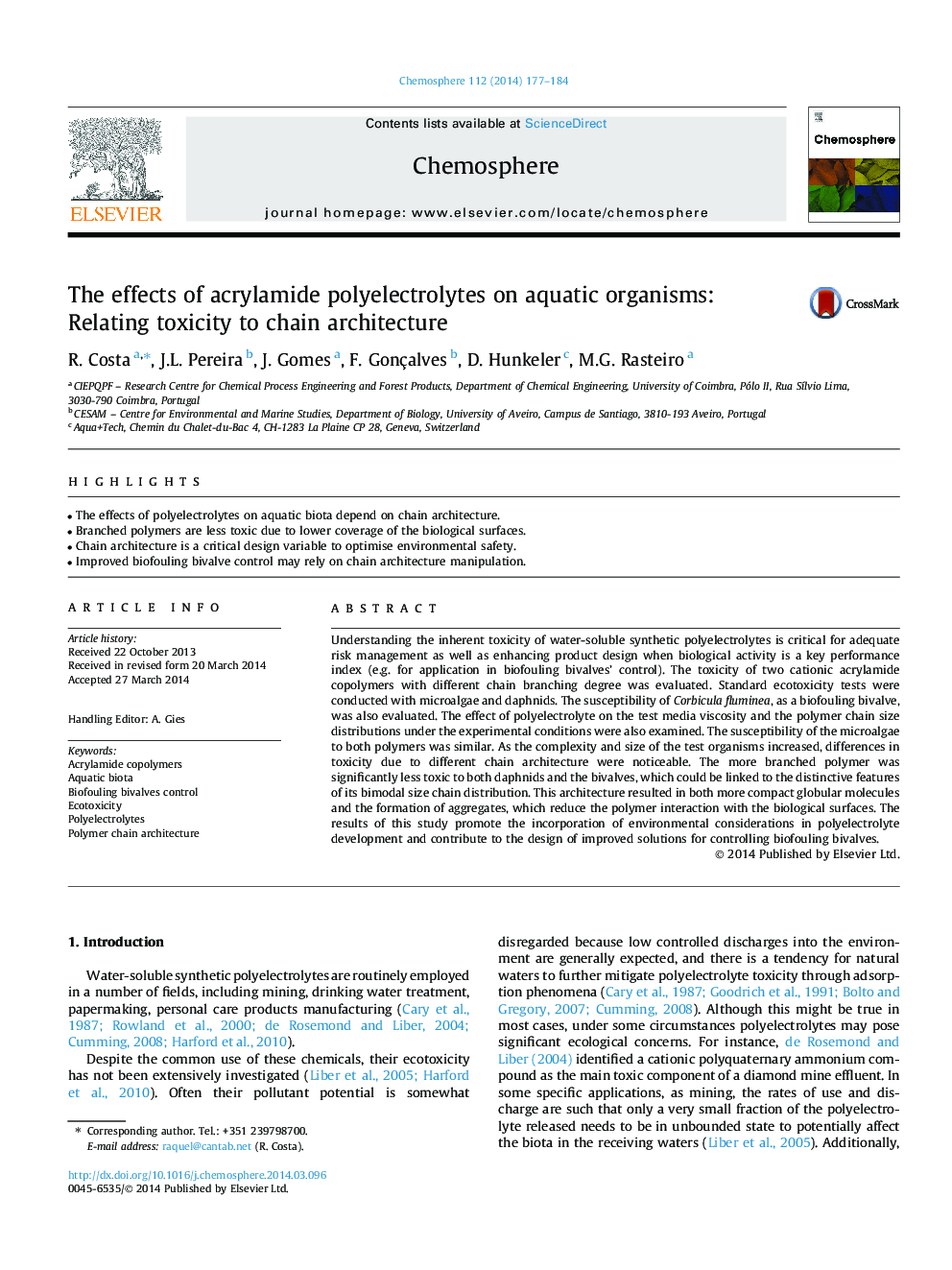| کد مقاله | کد نشریه | سال انتشار | مقاله انگلیسی | نسخه تمام متن |
|---|---|---|---|---|
| 6308789 | 1618859 | 2014 | 8 صفحه PDF | دانلود رایگان |
عنوان انگلیسی مقاله ISI
The effects of acrylamide polyelectrolytes on aquatic organisms: Relating toxicity to chain architecture
ترجمه فارسی عنوان
اثرات پلی¬ الکترولیتی¬های آکریل آمید بر موجودات آبزی: ارتباط سمیت با معماری زنجیره ای
دانلود مقاله + سفارش ترجمه
دانلود مقاله ISI انگلیسی
رایگان برای ایرانیان
کلمات کلیدی
کوپلیمرهای آکریل آمید، زیست آبزیان، کنترل آفات دو سوکوره، سموم زیستی، پلی الکترولیت ها، معماری زنجیره پلیمر،
ترجمه چکیده
درک سمیت ذاتی پلی الکترولیتهای مصنوعی محلول در آب برای مدیریت ریسک کافی و همچنین افزایش طراحی محصول زمانی است که فعالیت بیولوژیکی یک شاخص عملکرد کلیدی (برای مثال در کنترل دوگانه زیست زیستی) حیاتی است. سمیت دو کپلیمرهای آکریل آمید کاتیونی با درجه شاخه زنجیری مختلف مورد بررسی قرار گرفت. تستهای استاندارد سمیت زیستی با میکرولیگا و دافنید انجام شد. حساسیت کوربیکولا فلومانا به عنوان یک ماده خشک انگور زیستی نیز مورد بررسی قرار گرفت. اثر پلی الکترولیت بر ویسکوزیته رسانه تست و توزیع اندازه زنجیره ای پلیمر در شرایط آزمایش نیز مورد بررسی قرار گرفت. حساسیت میکرولیزر به هر دو پلیمر مشابه بود. با توجه به پیچیدگی و اندازه گیاهان تست، اختلاف در سمیت با توجه به معماری زنجیره ای مختلف قابل توجه بود. بیشتر پلیمرهای شاخه دار به طور معنی داری کمتر برای سدیم و دوگانگی سمی بود، که می توانست با ویژگی های متمایز توزیع زنجیره اندازه دوبعدی آن ارتباط داشته باشد. این معماری منجر به هر دو مولکول های کوچکتر کروی و شکل گیری دانه ها می شود که باعث کاهش تعامل پلیمر با سطوح بیولوژیکی می شود. نتایج این مطالعه، ترویج ترکیب ملاحظات محیطی در توسعه پلی یک الکترولیت است و به طراحی راهکارهای بهبود یافته برای کنترل دوغابهای زیستی متوسل می شود.
موضوعات مرتبط
علوم زیستی و بیوفناوری
علوم محیط زیست
شیمی زیست محیطی
چکیده انگلیسی
Understanding the inherent toxicity of water-soluble synthetic polyelectrolytes is critical for adequate risk management as well as enhancing product design when biological activity is a key performance index (e.g. for application in biofouling bivalves' control). The toxicity of two cationic acrylamide copolymers with different chain branching degree was evaluated. Standard ecotoxicity tests were conducted with microalgae and daphnids. The susceptibility of Corbicula fluminea, as a biofouling bivalve, was also evaluated. The effect of polyelectrolyte on the test media viscosity and the polymer chain size distributions under the experimental conditions were also examined. The susceptibility of the microalgae to both polymers was similar. As the complexity and size of the test organisms increased, differences in toxicity due to different chain architecture were noticeable. The more branched polymer was significantly less toxic to both daphnids and the bivalves, which could be linked to the distinctive features of its bimodal size chain distribution. This architecture resulted in both more compact globular molecules and the formation of aggregates, which reduce the polymer interaction with the biological surfaces. The results of this study promote the incorporation of environmental considerations in polyelectrolyte development and contribute to the design of improved solutions for controlling biofouling bivalves.
ناشر
Database: Elsevier - ScienceDirect (ساینس دایرکت)
Journal: Chemosphere - Volume 112, October 2014, Pages 177-184
Journal: Chemosphere - Volume 112, October 2014, Pages 177-184
نویسندگان
R. Costa, J.L. Pereira, J. Gomes, F. Gonçalves, D. Hunkeler, M.G. Rasteiro,
